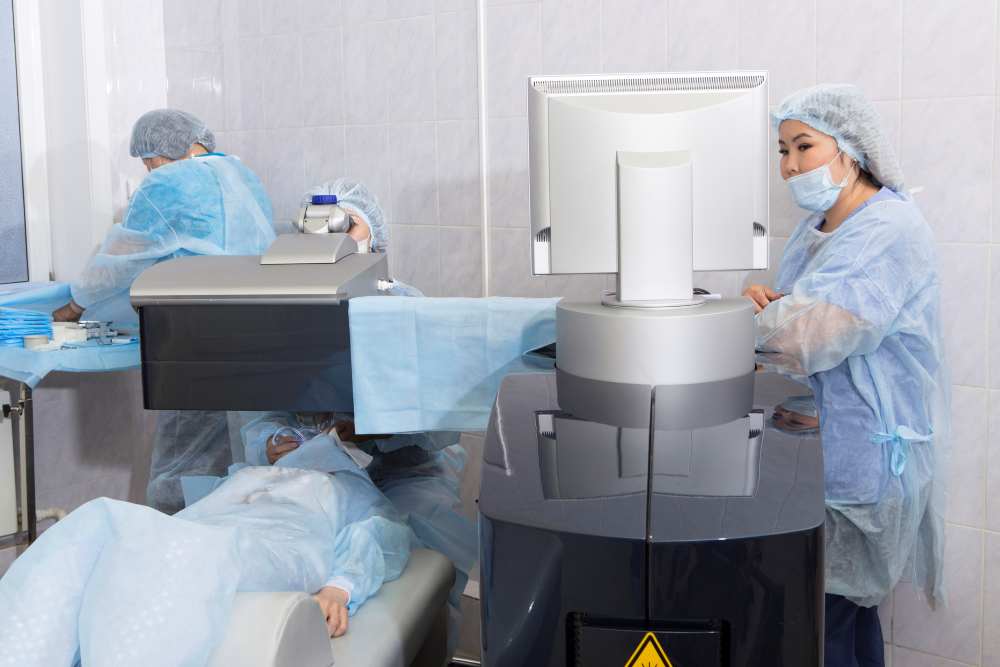
Farsightedness, or hyperopia, affects millions, making nearby objects appear blurry while distant ones remain clear. If you rely on glasses to read or find close-up tasks challenging, you may have this common refractive error. Understanding the options—from eyeglasses to advanced LASIK surgery—can help you find the best solution for clear vision and comfort.
Why Are You Farsighted?
When we look at an object, light enters the eye and focuses on the retina at the back of the eye, which then sends a clear image to the brain. In an eye with hyperopia or farsightedness, light focuses behind the retina instead of directly on it, causing close objects to appear blurry.
Hyperopia can occur at any age, affecting about 5-10% of the population, and differs from presbyopia, an age-related condition common after age 40. Hyperopia is often due to the shape of the cornea or the eye’s length, which can make tasks like reading challenging. Fortunately, several effective treatments can help correct this refractive error and clarify close-up vision.

Enhanced Treatment Options for Farsightedness
1. Eyeglasses
The simplest way to correct hyperopia is with eyeglasses. The lenses in glasses adjust the angle at which light enters the eye, helping focus it correctly on the retina. An optometrist or ophthalmologist can examine your eyes and prescribe lenses tailored to your needs, providing clarity for close-up tasks.
2. Contact Lenses for Correcting Farsightedness

Contact lenses are small, concave plastic circles that float on the surface of your eye. Your prescription for contacts differs from eyeglasses because the lens is directly on the eye. This allows for immediate vision correction as light enters the cornea. Contact lenses also come in bifocals or trifocals and can even change the color of your eye.
Types of Contact Lenses:
There are different types of contact lenses:
- Soft lenses: Made from flexible plastic, soft lenses cover the pupil, iris, and part of the sclera. Most are for daily wear, though some are approved for extended use. Some soft lenses are weighted to keep the correction in place.
- Rigid gas-permeable lenses (RGP): Smaller and more rigid, RGP lenses hold the eye’s shape and allow oxygen to reach the cornea. These are typically worn daily and removed at night, though some versions allow for extended wear.
- Monovision: A setup where one lens is corrected for far vision in one eye and for close vision in the other. The brain merges the two images, providing a clear, balanced view.
3. Laser Eye Surgery for Farsightedness

Laser eye surgery offers a long-term solution for hyperopia by reshaping the cornea to focus light correctly on the retina. This procedure is quick, effective, and requires minimal recovery time. Here’s a breakdown of two popular laser treatments:
LASIK Surgery
LASIK is the most common and well-known laser surgery procedure for correcting farsightedness. Here’s how it works:
- A small suction ring holds the cornea in place to keep it perfectly still.
- A thin, hinged flap is created on the cornea and gently folded back.
- The laser sculpts the cornea according to the doctor’s prescription, reshaping it to correct vision.
- The corneal flap is repositioned, requiring no stitches.
- Results: Patients often notice improved vision immediately.
Benefits:
- Quick procedure, typically completed in 15-30 minutes.
- Outpatient setting with minimal discomfort.
- Rapid recovery, with noticeable vision improvement within 24 hours.
Considering LASIK for farsightedness? Learn more about these8 questions to ask your surgeon before LASIK treatment.
PRK Surgery
For patients with thinner corneas, PRK offers an alternative to LASIK. In PRK:
- The cornea’s outer layer is gently removed instead of creating a flap.
- The underlying cornea is reshaped to correct vision.
Benefits:
- Ideal for patients with thin corneas or dry eyes.
- Same vision improvement as LASIK over time.
- Slightly longer recovery period, as the corneal layer regenerates over a few days.
Each of these surgeries is tailored to the patient’s eye health and vision goals. Your ophthalmologist can help determine the best option for your needs.
Farsightedness Treatment Options: Pros and Cons Comparison
| Treatment Option | Pros | Cons | Ideal For |
|---|---|---|---|
| Eyeglasses | Easy, non-invasive | Temporary solution | General use |
| Contact Lenses | Corrects on-eye for sharper vision | Requires upkeep | Active lifestyles |
| LASIK | Long-term solution, minimal downtime | Not ideal for thin corneas | Adults with stable vision |
| PRK | Suitable for thin corneas | Longer recovery time | Patients with corneal limits |
FAQs on Farsightedness Treatments
- Q: Does LASIK work for all ages?
- A: Generally, LASIK is recommended for patients over 18 with stable vision.
- Q: How long does LASIK recovery take?
- A: Most people experience vision improvement within 24 hours, with complete recovery in a few days.
Not Sure if LASIK is Right for You?
Take our quick Interactive LASIK Quiz
to see if you’re a good candidate for LASIK or PRK!
Ready to Improve Your Vision?
Schedule a consultation to find the best farsightedness solution for you!
Book an appointment online today.

